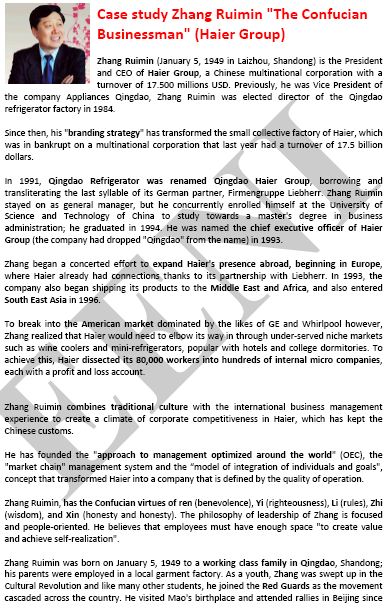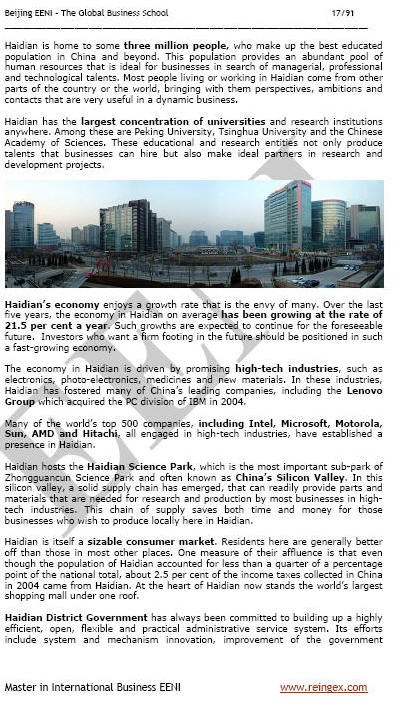Introduction to China

Introduction to China. Economic Profile of the Chinese provinces
- Introduction to China
- History of China
- Chinese Geography: rivers, mountains, climate
- Chinese Population
- Main ethnic groups in China. Han People
- Chinese Government
- Ministry of Finance and Commerce
- Administrative division of China
- Provinces, autonomous regions, and municipalities
- Economic Profile of the largest Chinese provinces
- Main cities in China: Beijing, Shanghai, Tianjin, Chongqing
Religions in China.


The Subject “Economic Profile of the Chinese provinces” belongs to the following Online Programs taught by EENI Global Business School:
Masters: International Business, Foreign Trade.
Course: Taoism, Confucianism & Business.


Economic Profile of the Chinese provinces.
- The People's Republic of China is the third largest nation in the World
- Chinese population: 1,369,000 people (the most populous country)
- The capital of China is Beijing
- The city for business is Shanghai (24.2 million people)
- Area of China: 9,596,961 km²
- The main language of China is Mandarin Chinese
- Other languages: Cantonese Chinese, Mongolian, Tibetan, Uyghur, and Chuang


- Type of Government: State socialist (market economy)
- China has two Special Administrative Regions: Hong Kong and Macau
- Borders of China: Mongolia, North Korea, Vietnam, Laos, Myanmar, Bhutan, Nepal, Bharat (India), Afghanistan, Tajikistan, the Kyrgyz Republic, Kazakhstan, South Korea, and Macau
- China shares sea borders with South Korea, the Philippines, Japan, Vietnam, and Taiwan
- Chinese currency: Renminbi (CNY)
- Abolition of Slavery in China: 1910
Major religions in China: Confucianism, Taoism, Buddhism, and Christianity
- China is the Central State of the Sinic Civilization but may also belong to the Buddhist Civilization

China is a nation with a very early Civilization and a long history. The ancient Chinese has invented: compass, gunpowder, paper-making art or block printing. The Great Wall or the Grand Canal built by the Chinese people are regarded as an engineering achievement of all the times.
China is divided into provinces, autonomous regions, and municipalities. A province or an autonomous region is subdivided into autonomous prefectures, counties, autonomous counties and /or cities. A county or an autonomous county is subdivided into townships, ethnic townships, and/or towns.
China is a tied multi-ethnic nation (fifty-six Ethnic Groups). The majority ethnic group in China is the Han (91.6%). The fifty-five ethnic Groups of China are referred to as ethnic minorities.
Chinese largest economic areas.
In the vast China we can define three major geographical and economic regions:
- The Gulf of Bohai, with the Beijing-Tianjin axis and its economic influence area (Liaoning, Shandong, and Hebei)
- The Yangtze River Delta, with its large centre in Shanghai and its economic influence area (Jiangsu, Zhejiang)
- The Pearl River Delta, in the province of Guangdong (Special Economic Zones of Guangzhou, Shenzhen, and Zhuhai) as the main axis
Five major geographical areas.
From another point of view, the Chinese market can be divided into five geographical areas:
- East China, with Shanghai as the centre. Shanghai is the most populous city in China and has, with a catchment area that includes the provinces of Zhejiang (Hangzhou), Jiangsu (Nanjing) and Anhui (Hefei)
- South of China, with Guangdong as the centre
- The largest market in Southwest, with Sichuan as the centre
- The market of Northeast China, with Harbin as the centre
- The North market with Beijing as the centre. Tianjin is the input port of Beijing; Qingdao is the input port of Shandong and Dalian of Liaoning Province




 or
or 

